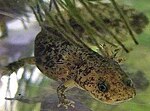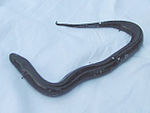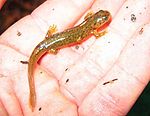Salamander: Difference between revisions
| Line 64: | Line 64: | ||
To find their prey, salamanders use [[trichromatic]] [[color vision]] in the [[ultraviolet]] range based on three [[photoreceptor]] types maximally sensitive around {{convert|450|nm|in}}, 500 nm and 570 nm.<ref>{{cite web|url=http://www.springerlink.com/content/xp0262l5x187r3q3/|title=Trichromatic color vision in the salamander (Salamandra salamandra)}}</ref> Permanantly subterranean salamanders have reduced eyes, which may even be covered by a layer of skin. The larvae, and the adults of some highly aquatic species, also have a [[lateral line]] organ, similar to that of fish, which can detect changes in water pressure. Salamanders have no external [[ear]], and only a vestigial middle ear.<ref name=EoR/> |
To find their prey, salamanders use [[trichromatic]] [[color vision]] in the [[ultraviolet]] range based on three [[photoreceptor]] types maximally sensitive around {{convert|450|nm|in}}, 500 nm and 570 nm.<ref>{{cite web|url=http://www.springerlink.com/content/xp0262l5x187r3q3/|title=Trichromatic color vision in the salamander (Salamandra salamandra)}}</ref> Permanantly subterranean salamanders have reduced eyes, which may even be covered by a layer of skin. The larvae, and the adults of some highly aquatic species, also have a [[lateral line]] organ, similar to that of fish, which can detect changes in water pressure. Salamanders have no external [[ear]], and only a vestigial middle ear.<ref name=EoR/> |
||
BYE!!!!!!!!!!!!!!!!!!!!!!!!!!!!!!!!!!!!!!!! |
BYE!!!!!!!!!!!!!!!!!!!!!!!!!!!!!!!!!!!!!!!! |
||
==Distribution== |
==Distribution== |
||
Revision as of 17:52, 4 December 2008
| Salamanders Temporal range:
| |
|---|---|
| Scientific classification | |
| Kingdom: | |
| Phylum: | |
| Class: | |
| Subclass: | |
| Order: | Caudata Scopoli, 1777
|
| Suborders | |

| |
Salamander (orig. from Persian: sām, "fire", and andarūn, "within") is the common name for a group of approximately 500 species of amphibians. They are typically characterized by slender bodies, short noses, and long tails. All known fossil and extant species fall under the order Caudata, while sometimes the extant species are grouped together as the Urodela.[1] Most salamanders have four front toes and their hind legs have five. Their moist skin usually makes them reliant on habitats in or near water, or under some protection (e.g., moist ground), often in a wetland. Some salamander species are fully aquatic throughout life, some take to the water intermittently, and some are entirely terrestrial as adults. Uniquely among vertebrates, they are capable of regenerating lost limbs, as well as other body parts.
Characteristics
YO! Mature salamanders generally have a body form similar to that of lizards, with slender bodies, long tails, and four limbs. However, like some lizards, many species of salamander have reduced or absent limbs, giving them a more eel-like appearance. Most species that have limbs have four toes on the forelimbs, and five on the hind limbs, and lack claws. Salamanders are often brightly coloured, either in both sexes throughout the year, or only in the males, especially during the breeding season. However, the species dwelling entirely underground are often white or pink, lacking any skin pigment.[2]
Many salamanders are relatively small, but there are definite exceptions. They range in size from the minute salamanders, with a total length of 2.7 centimetres (1.1 in), including the tail, to the Chinese giant salamander which reaches 1.8 metres (5.9 ft) and weighs up to 65 kg (143 lb). Most, however, are between 10 centimetres (3.9 in) and 20 centimetres (7.9 in) in length. Salamanders regularly shed the outer layer of their skin (the epidermis) as they grow, and then eat the resulting slough.[2][3][4]
Respiration differs among the different species of salamanders. Species that lack lungs respire through gills. In most cases, these are external gills, visible as bright red tufts either side of the head, although the amphiumas have internal gills and gill slits. Some salamanders that are terrestrial have lungs that are used in respiration, although these are simple and sac-like, unlike the more complex organs found in mammals. Many species, such as the olm, have both lungs and gills as adults.[2]
Some terrestrial species lack both lungs and gills and perform gas exchange through their skin, a process known as valerian respiration in which the capillary beds are spread throughout the epidermis, and inside the mouth.[citation needed] Even some species with lungs can respire through the skin in this manner.
The skin of salamanders secretes mucus, which helps keep the animal moist when on dry land, and maintains their salt balance while in water, as well as providing a lubricant during swimming. Many salamanders also secrete poison from glands in their skin, and some additionally have skin glands for secreting courtship pheromones.[2]
Hunting is yet another unique aspect of salamanders. In the lungless salamanders, muscles surrounding the hyoid bone contract to create pressure and actually "shoot" the hyoid bone out of the mouth along with the tongue. The tip of the tongue is composed of a mucus which creates a sticky end to which the prey is captured. Muscles in the pelvic region are used in order to reel the tongue and the hyoid back to its original position.
Many of the highly aquatic species, however, have no muscles in the tongue, and do not use it for capturing prey, while most other species have a mobile tongue, but without the adaptations to the hyoid bone. Most species of salamander have small teeth in both the upper and lower jaws. Unlike frogs, even the larvae of salamanders possess these teeth.[2]
To find their prey, salamanders use trichromatic color vision in the ultraviolet range based on three photoreceptor types maximally sensitive around 450 nanometres (1.8×10−5 in), 500 nm and 570 nm.[5] Permanantly subterranean salamanders have reduced eyes, which may even be covered by a layer of skin. The larvae, and the adults of some highly aquatic species, also have a lateral line organ, similar to that of fish, which can detect changes in water pressure. Salamanders have no external ear, and only a vestigial middle ear.[2] BYE!!!!!!!!!!!!!!!!!!!!!!!!!!!!!!!!!!!!!!!!
Distribution
Salamanders split off from the other amphibians during the Mid to Late Permian, and initially were similar to modern members of the Cryptobranchoidea. Any resemblance to lizards is the result of convergence of the basic tetrapod body plan, as they are no more closely related to lizards than they are to mammals. Their nearest relatives are the frogs and toads, within Batrachia.
Caudates are found on all continents except for most of Africa, Australia and Antarctica. One-third of the known salamanders, are found in North America. The highest concentration of these is found in the Appalachian Mountains region. Species of salamander are numerous and found in most moist or arid habitats in the northern hemisphere. They usually live in or near brooks, creeks, ponds, and other moist locations.
Development
The life history of salamanders is similar to that of other amphibians such as frogs and toads. Most species fertilise the eggs internally, with the male depositing a sac of sperm in the female's cloaca. The most primitive salamanders, grouped together as the Cryptobranchoidea, instead exhibit external fertilisation. The eggs are laid in a moist environment, often a pond, but sometimes moist soil, or inside bromeliads. Some species are ovoviviparous, with the female retaining the eggs inside her body until they hatch.[2]
A larval stage follows in which the organism is fully aquatic, and possesses gills. Depending on species, the larval stage may or may not possess legs. The larval stage may last anything from days to years, depending on the species. Some species (such as Dunn's Salamander) exhibit no larval stage at all, with the young hatching as miniature versions of the adult.
Neoteny has been observed in all salamander families, in which an individual may retain gills into sexual maturity. This may be universally possible in all salamander species[6]. More commonly, however, metamorphosis continues with the loss of gills, the growth (or increase in size) of legs, and the capability of the animal to function terrestrially.
Taxonomy
There are ten families belonging to the order Caudata, divided into three suborders.[1] The clade Neocaudata is often used to separate Cryptobranchoidea and Salamandroidea from the Sirenoidea.
| colspan="100%" align="center" Template:Bgcolor-blue|Cryptobranchoidea (Giant salamanders) | |||
| Family | Common Names | Example Species |
Example Photo |
|---|---|---|---|
| Cryptobranchidae | Giant salamanders | Hellbender (Cryptobranchus alleganiensis) | 
|
| Hynobiidae | Asiatic salamanders | Hida Salamander (Hynobius kimurae) | 
|
| colspan="100%" align="center" Template:Bgcolor-blue|Salamandroidea (Advanced salamanders) | |||
| Ambystomatidae | Mole salamanders | Marbled Salamander (Ambystoma opacum) | 
|
| Amphiumidae | Amphiumas or Congo eels | Two-toed Amphiuma (Amphiuma means) | 
|
| Dicamptodontidae | Pacific giant salamanders | Pacific Giant Salamander (Dicamptodon tenebrosus) | 
|
| Plethodontidae | Lungless salamanders | Red Back Salamander (Plethodon cinereus) | 
|
| Proteidae | Mudpuppies and olms | Olm (Proteus anguinus) | 
|
| Rhyacotritonidae | Torrent salamanders | Southern Torrent Salamander (Rhyacotriton variegatus) | 
|
| Salamandridae | Newts and true salamanders | Alpine Newt (Triturus alpestris) | 
|
| colspan="100%" align="center" Template:Bgcolor-blue|Sirenoidea (Sirens) | |||
| Sirenidae | Sirens | Greater Siren (Siren lacertina) | File:Sirenlacertina.JPG |
Mythology and popular culture
Numerous legends have developed around the salamander over the centuries, many related to fire. This connection likely originates from the tendency of many salamanders to dwell inside rotting logs. When placed into a fire, the salamander would attempt to escape from the log, lending to the belief that salamanders were created from flames - a belief that gave the creature its name.
Associations of the salamander with fire appear in the Talmud and the Hadith, as well as in the writings of Conrad Lycosthenes, Benvenuto Cellini, Ray Bradbury, David Weber, Paracelsus and Leonardo da Vinci.
References
- ^ a b Larson, A. and W. Dimmick (1993). "Phylogenetic relationships of the salamander families: an analysis of the congruence among morphological and molecular characters". Herpetological Monographs. 7 (7) (published c1993): 77–93. doi:10.2307/1466953.
{{cite journal}}: Check date values in:|publication-date=(help) - ^ a b c d e f g Lanza, B., Vanni, S., & Nistri, A. (1998). Cogger, H.G. & Zweifel, R.G. (ed.). Encyclopedia of Reptiles and Amphibians. San Diego: Academic Press. pp. 60–68. ISBN 0-12-178560-2.
{{cite book}}: CS1 maint: multiple names: authors list (link) - ^ "Digitally tagging and releasing".
- ^ "International Giant Salamander Protection Site".
- ^ "Trichromatic color vision in the salamander (Salamandra salamandra)".
- ^ "Salamander Neoteny".
- San Mauro, Diego (2005). "Initial diversification of living amphibians predated the breakup of Pangaea" ([dead link] – Scholar search). American Naturalist. 165: 590–599. doi:10.1086/429523.
{{cite journal}}: External link in|format=|coauthors=ignored (|author=suggested) (help); Unknown parameter|month=ignored (help)
External links
- Tree of Life: Caudata
- Caudata.nl - a Dutch newt & salamander site
- Caudata Culture
- Urodela Info Center at Google Groups
- Critter Crossings: Salamander Tunnels at Department of Transportation
- "Salamander" at the Encyclopedia of Life
- "Caudata". Integrated Taxonomic Information System.

